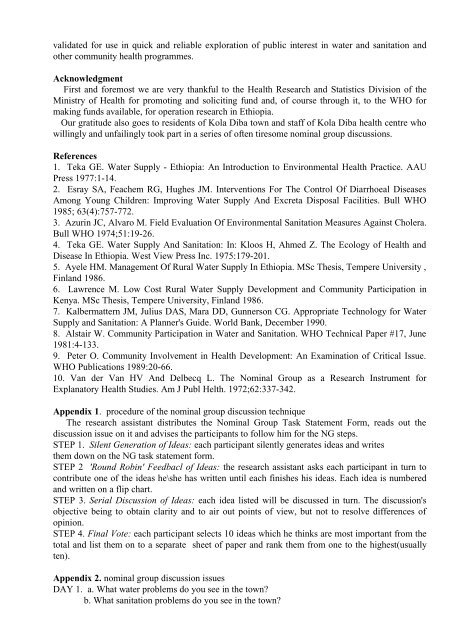Original article - Ethiopian Review
Original article - Ethiopian Review
Original article - Ethiopian Review
- No tags were found...
You also want an ePaper? Increase the reach of your titles
YUMPU automatically turns print PDFs into web optimized ePapers that Google loves.
validated for use in quick and reliable exploration of public interest in water and sanitation andother community health programmes.AcknowledgmentFirst and foremost we are very thankful to the Health Research and Statistics Division of theMinistry of Health for promoting and soliciting fund and, of course through it, to the WHO formaking funds available, for operation research in Ethiopia.Our gratitude also goes to residents of Kola Diba town and staff of Kola Diba health centre whowillingly and unfailingly took part in a series of often tiresome nominal group discussions.References1. Teka GE. Water Supply - Ethiopia: An Introduction to Environmental Health Practice. AAUPress 1977:1-14.2. Esray SA, Feachem RG, Hughes JM. Interventions For The Control Of Diarrhoeal DiseasesAmong Young Children: Improving Water Supply And Excreta Disposal Facilities. Bull WHO1985; 63(4):757-772.3. Azurin JC, Alvaro M. Field Evaluation Of Environmental Sanitation Measures Against Cholera.Bull WHO 1974;51:19-26.4. Teka GE. Water Supply And Sanitation: In: Kloos H, Ahmed Z. The Ecology of Health andDisease In Ethiopia. West View Press Inc. 1975:179-201.5. Ayele HM. Management Of Rural Water Supply In Ethiopia. MSc Thesis, Tempere University ,Finland 1986.6. Lawrence M. Low Cost Rural Water Supply Development and Community Participation inKenya. MSc Thesis, Tempere University, Finland 1986.7. Kalbermattern JM, Julius DAS, Mara DD, Gunnerson CG. Appropriate Technology for WaterSupply and Sanitation: A Planner's Guide. World Bank, December 1990.8. Alstair W. Community Participation in Water and Sanitation. WHO Technical Paper #17, June1981:4-133.9. Peter O. Community Involvement in Health Development: An Examination of Critical Issue.WHO Publications 1989:20-66.10. Van der Van HV And Delbecq L. The Nominal Group as a Research Instrument forExplanatory Health Studies. Am J Publ Helth. 1972;62:337-342.Appendix 1. procedure of the nominal group discussion techniqueThe research assistant distributes the Nominal Group Task Statement Form, reads out thediscussion issue on it and advises the participants to follow him for the NG steps.STEP 1. Silent Generation of Ideas: each participant silently generates ideas and writesthem down on the NG task statement form.STEP 2 'Round Robin' Feedbacl of Ideas: the research assistant asks each participant in turn tocontribute one of the ideas he\she has written until each finishes his ideas. Each idea is numberedand written on a flip chart.STEP 3. Serial Discussion of Ideas: each idea listed will be discussed in turn. The discussion'sobjective being to obtain clarity and to air out points of view, but not to resolve differences ofopinion.STEP 4. Final Vote: each participant selects 10 ideas which he thinks are most important from thetotal and list them on to a separate sheet of paper and rank them from one to the highest(usuallyten).Appendix 2. nominal group discussion issuesDAY 1. a. What water problems do you see in the town?b. What sanitation problems do you see in the town?




![to read the full report [pdf, Amharic] - Ethiopian Review](https://img.yumpu.com/52737829/1/190x245/to-read-the-full-report-pdf-amharic-ethiopian-review.jpg?quality=85)











